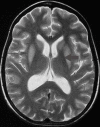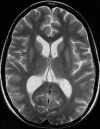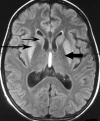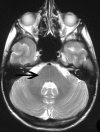Extrapontine myelinolysis presenting as acute parkinsonism
- PMID: 16961933
- PMCID: PMC1592301
- DOI: 10.1186/1471-2377-6-33
Extrapontine myelinolysis presenting as acute parkinsonism
Abstract
Background: Extrapontine myelinolysis presenting with extra pyramidal features suggestive of parkinsonism may be a challenging clinical syndrome. Clinicians should maintain their vigilance while correcting electrolyte imbalances, especially with associated co-morbidity.
Case presentation: A 41-year-old woman presented with acute parkinsonism like features while on a holiday. This followed slow correction of hyponatraemia after repeated vomiting. MRI changes were suggestive of Extrapontine myelinolysis(EPM). This case is at variance with four previous cases reported in the medical literature in that the patient made a full clinical recovery and the MR changes resolved with symptomatic support alone.
Conclusion: Extrapontine myelinolysis could make a complete recovery with symptomatic support alone. During hyponatraemia correction, rapid osmotic shifts of fluid that cause hypernatremia, causes myelinolysis rather than absolute serum sodium level. Even gradual correction of hyponatraemia can produce myelinolysis, especially with pre-existing malnourishment, alcoholism, drug misuse, Addison's disease and immuno-suppression. Pallidial sparing is typical of EPM in MRI scans.
Figures




Similar articles
-
[A case of central pontine myelinolysis and extrapontine myelinolysis during rapid correction of hypernatremia].Rinsho Shinkeigaku. 1994 Nov;34(11):1130-5. Rinsho Shinkeigaku. 1994. PMID: 7729094 Review. Japanese.
-
Extrapontine myelinolysis manifested selectively by acute severe parkinsonian syndrome. Case Report.Neuro Endocrinol Lett. 2016 Nov;37(6):415-418. Neuro Endocrinol Lett. 2016. PMID: 28315624
-
Parkinsonism and dystonia in central pontine and extrapontine myelinolysis.J Neurol Neurosurg Psychiatry. 1998 Jul;65(1):119-21. doi: 10.1136/jnnp.65.1.119. J Neurol Neurosurg Psychiatry. 1998. PMID: 9667573 Free PMC article. Review.
-
Extrapontine myelinolysis associated with severe hypernatremia in infancy.Pediatr Int. 2016 Sep;58(9):936-9. doi: 10.1111/ped.13042. Epub 2016 Jul 27. Pediatr Int. 2016. PMID: 27463219
-
Extrapontine Myelinolysis and Reversible Parkinsonism After Hyponatremia Correction in a Case of Pituitary Adenoma: Hypopituitarism as a Predisposition for Osmotic Demyelination.World Neurosurg. 2018 Oct;118:304-310. doi: 10.1016/j.wneu.2018.07.115. Epub 2018 Jul 25. World Neurosurg. 2018. PMID: 30055367 Review.
Cited by
-
A case of acute onset parkinsonism.Qatar Med J. 2013 Dec 23;2013(2):29-32. doi: 10.5339/qmj.2013.12. eCollection 2013. Qatar Med J. 2013. PMID: 25003061 Free PMC article.
-
The Dilemma of Inadvertent Pontine Demyelinosis: A Review of Literature.Cureus. 2018 Aug 21;10(8):e3174. doi: 10.7759/cureus.3174. Cureus. 2018. PMID: 30357070 Free PMC article. Review.
-
Extra-pontine Myelinolysis After Rapid Correction of Hyponatremia Responding to Levodopa.Cureus. 2024 Jan 22;16(1):e52707. doi: 10.7759/cureus.52707. eCollection 2024 Jan. Cureus. 2024. PMID: 38384610 Free PMC article.
-
Temporal Brain MRI Changes From Extrapontine Myelinolysis to Central Pontine Myelinolysis: A Case Report.Cureus. 2021 Nov 6;13(11):e19318. doi: 10.7759/cureus.19318. eCollection 2021 Nov. Cureus. 2021. PMID: 34909286 Free PMC article.
-
Parkinsonism and neurosarcoidosis: Cause and effect or coincidence?Clin Park Relat Disord. 2019 Sep 12;1:74-76. doi: 10.1016/j.prdoa.2019.09.001. eCollection 2019. Clin Park Relat Disord. 2019. PMID: 34316605 Free PMC article.
References
Publication types
MeSH terms
LinkOut - more resources
Full Text Sources

